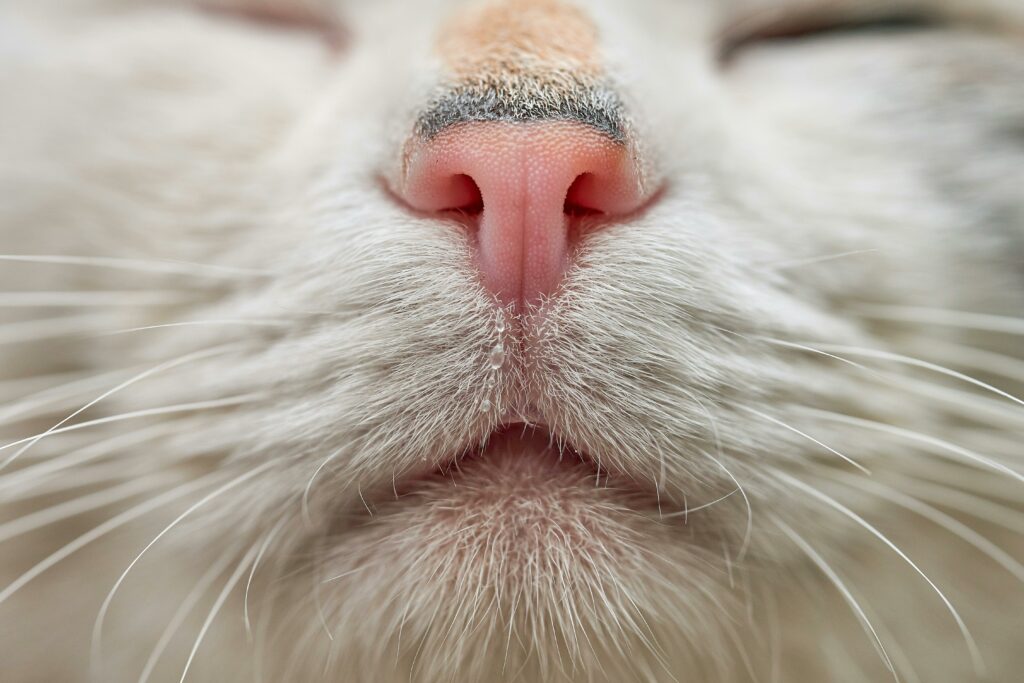
Cats are enigmatic creatures with unique habits that often leave their human companions puzzled. One behavior that stands out is their tendency to sniff each other’s butts. While it may seem odd or even amusing to us, this greeting plays a significant role in feline communication. In this article, we’ll explore why cats sniff butts, uncovering the science behind this seemingly strange behavior and its importance in the feline world.

The Science of Cat Scent Communication
Cats and Their Highly Sensitive Noses
Cats have an extraordinary sense of smell. While humans possess about 5 million olfactory receptors, cats boast an impressive 200 million. This acute sense allows them to detect intricate scent details that are imperceptible to us.
Sniffing another cat’s rear end is a way for them to tap into this heightened ability. The anal glands located near the base of the tail secrete pheromones that carry a wealth of information, such as:
- Identity
- Health status
- Sexual maturity
- Emotional state
Why Cats Sniff Butts: Instinctual Behavior
When cats sniff each other’s butts, they’re essentially engaging in a form of scent-based communication. This behavior is rooted in their instincts and is part of their natural social interactions.
- Information Gathering: Cats use scent to learn about the other cat. A quick sniff can reveal whether the other feline is a friend, foe, or potential mate.
- Establishing Dominance: Sniffing can help determine the social hierarchy. Cats that willingly allow their rear to be sniffed may display submissiveness, while those who initiate the sniffing might assert dominance.
Comparing Feline and Canine Greetings
Cats aren’t the only animals that rely on scent-based greetings. Dogs, for instance, also sniff each other’s behinds. However, there are some distinct differences:
- Cats typically approach these interactions more cautiously and are less likely to linger.
- The primary focus for cats is gathering social and health-related information, whereas dogs may also emphasize territory and pack dynamics.

The Role of the Jacobson’s Organ
One of the key anatomical features that enables cats to decode scents so effectively is the Jacobson’s organ (also known as the vomeronasal organ). Located on the roof of a cat’s mouth, this organ processes pheromones and other chemical signals.
When a cat engages in butt-sniffing, they may open their mouth slightly, a behavior known as the Flehman response, to allow the Jacobson’s organ to analyze the scent more thoroughly. This response provides deeper insight into the information carried by the other cat’s pheromones.
Is Butt-Sniffing Always a Friendly Gesture?
While butt-sniffing is a common feline greeting, it isn’t always welcomed. Cats are individuals with unique personalities, and their reactions to this behavior can vary:
- Friendly Interactions: In well-socialized cats, this greeting is usually mutual and non-threatening.
- Conflict or Aggression: If one cat feels threatened, the interaction might escalate into hissing or swatting.
- Avoidance: Some cats may simply walk away, signaling disinterest or discomfort.
What Should Cat Owners Know About This Behavior?
When to Intervene
In multi-cat households, butt-sniffing is a natural part of the social dynamic. However, it’s essential for cat owners to recognize when this behavior might signal a problem:
- Repeated Hostility: If sniffing consistently leads to aggression, it might be a sign of underlying tension.
- Health Concerns: Cats with anal gland issues may become more sensitive to being sniffed, leading to discomfort or avoidance.
Encouraging Healthy Socialization
To promote positive interactions:
- Introduce Cats Gradually: Use scent-swapping techniques, such as sharing bedding, to familiarize cats with each other before direct meetings.
- Provide Space: Ensure each cat has its own territory, including separate litter boxes and feeding areas.
Do Cats Sniff Human Butts Too?
Occasionally, cats may display similar sniffing behavior towards humans. While this might be amusing (or awkward), the underlying reason is the same: curiosity and scent-gathering. Cats rely on their noses to learn about their environment, and this includes their human companions.
Conclusion
Although butt-sniffing may seem odd to us, it’s a natural and essential part of feline communication. By sniffing each other’s butts, cats gather crucial information about one another, establish social bonds, and maintain harmony within their group. Understanding why cats sniff butts not only demystifies this quirky behavior but also fosters a greater appreciation for the complexity of our feline friends.
References:
- Why Cats Sniff Rear Ends – VCA Animal Hospitals
- Why Cats Sniff Each Other’s Butts – The Public Library of Science
- What Is the Vomeronasal Organ (Jacobson’s Organ) in Cats? Vet Approved Facts & FAQ – PangoVet
- The vomeronasal organ of the cat. – National Library of Medicine
- What Is the Flehmen Response in Cats? – PetMD






























